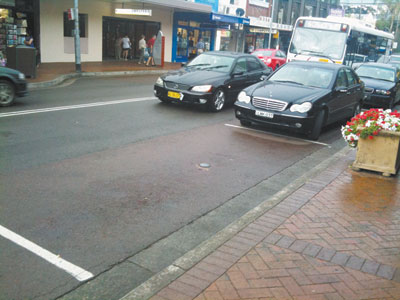Lane Cove Council on Sydney’s North Shore is one of a number of councils that has introduced electronic sensors to monitor parking and improve traffic flow within its busy parking areas.
With limited entry points and a number of retailers and their staff known to repeatedly park in time restricted zones, Council installed Metereye sensors in one of its most heavily used carparks in the Lane Cove Town Centre.
The wireless sensors sit above the ground in the centre of each carparking space so they are visible to motorists at all times.
Council has established a solar powered wireless network in the area that receives information from the sensors indicating car parking space availability, and how long the current vehicle has been there. This information is sent on to a central server, before being forwarded to digital guidance signs installed at the entrances to the carpark. It is also sent to Council Parking Rangers via their handheld devices.
Lane Cove’s General Manager Peter Brown said that the sensors were primarily installed to improve traffic flow in the carpark, which was quite often congested with motorists doing laps seeking an available parking space to no avail.
“The information captured from the sensors updates digital guidance signs that indicate the number of vacant spaces and directs motorists to those spaces,” he said.
“The information on the entrance signage assists managing traffic movements in the village and has helped to alleviate congestion within the car park.
“It has also assisted in managing parking demand along adjacent streets, and the data will be analysed by Council’s traffic engineers to refine parking management strategies for the village in the future.”
The sensors can be used to alert parking rangers when a car has overstayed the parking limit, but rangers must log in and physically query the data before issuing a fine.
“The main benefit for rangers is that it has replaced the need for traditional chalking – the sensors cannot be used to remotely issue a fine,” Peter Brown said. “The system provides the officer with a more accurate and efficient method of detecting vehicles overstaying the time limit. But a Parking Ranger must consider the data in context with the situation and determine if a fine should be issued.
“For example, in assessing an overstay, the Ranger will use the information in conjunction with any other contributing factors, such as whether a mobility permit is displayed, if a car has broken down, or a driver has just returned to their vehicle.”
Although there was some initial concern from the community about the system – inflamed by sensational media reports – both the Rangers and the community are responding positively to the sensors.
“Residents are pleased that the system has made parking easier for them – and it has also freed up a lot of places that were previously taken by staff at local stores,” Peter Brown said.
“The new technology benefits everyone – traders, customers and residents – by promoting higher turnover and availability of parking bays, allowing more people to access local businesses.”
For further information contact Steve Fedorow on (02) 9911 3613.








